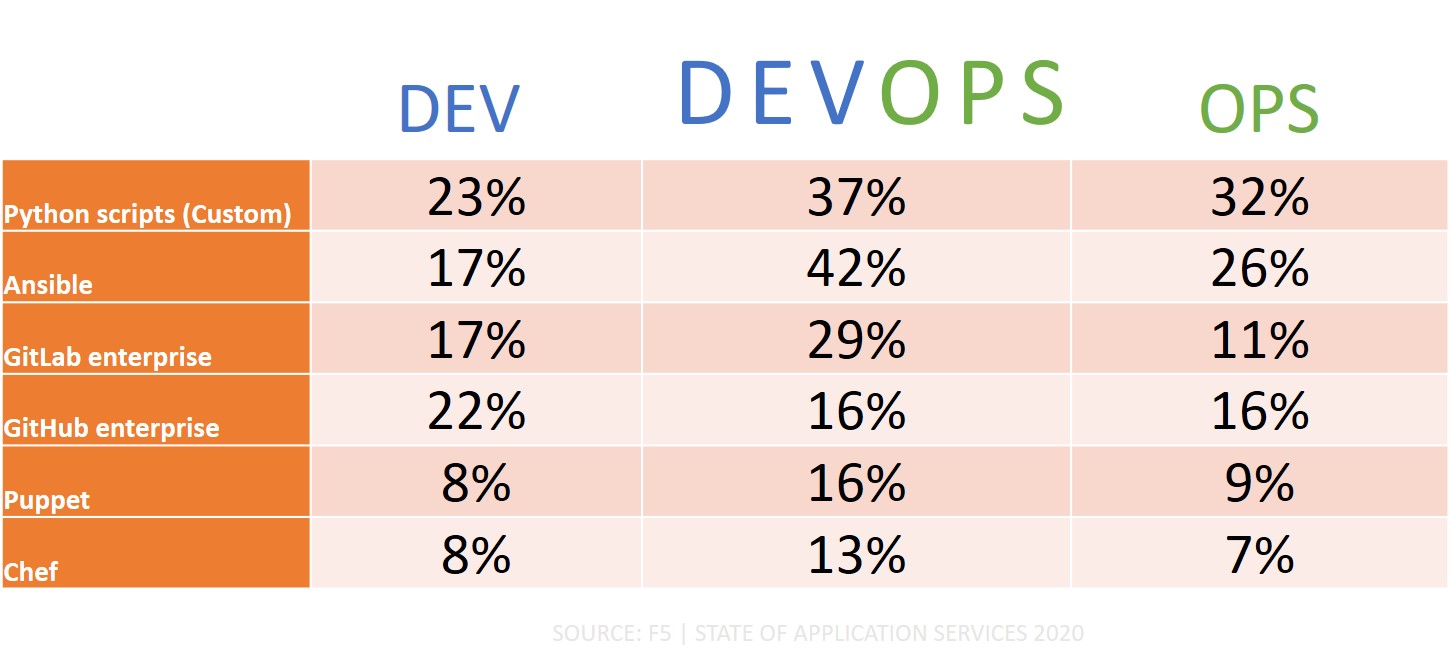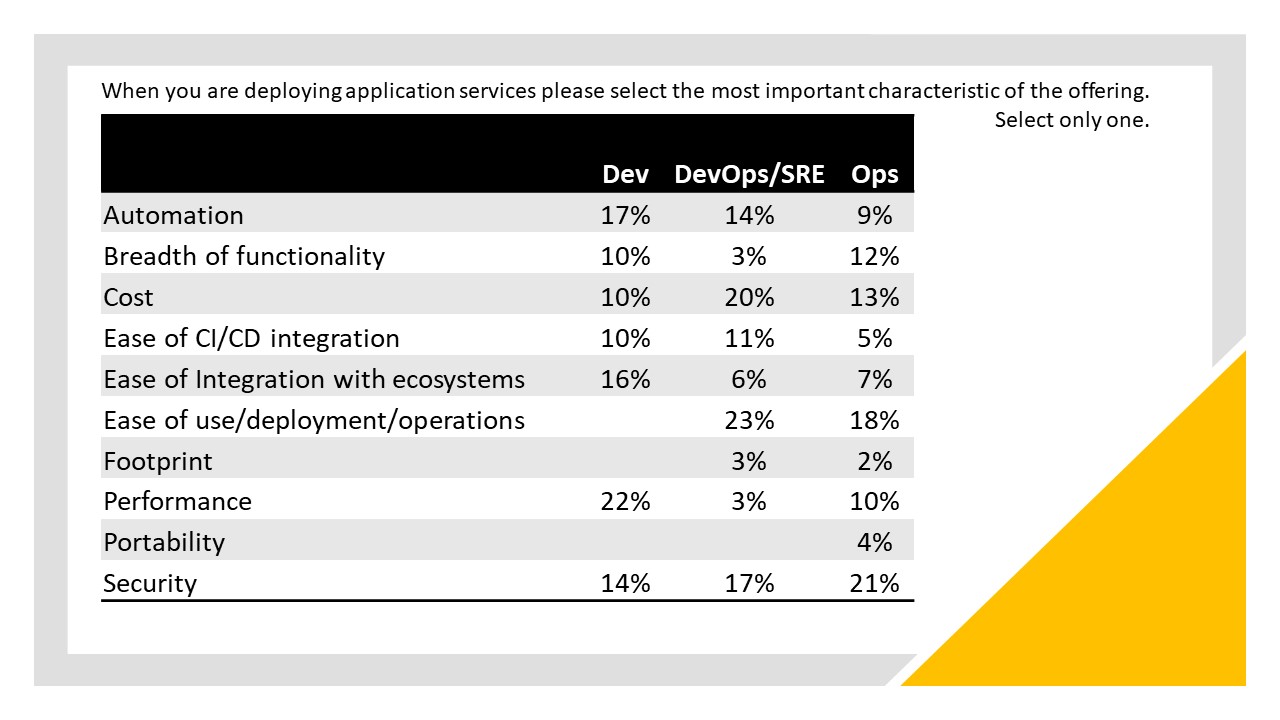O estado dos serviços de aplicativos em 2020: A Divisão DevOps
Há poder nos nomes, ou pelo menos é o que nos ensinaram os mitos, as lendas e os desenhos animados das manhãs de sábado. Shakespeare pode discordar, mas todo conto heroico dá nomes icônicos ao seu herói ou heroína.
Então, quando nomeamos algo, como DevOps, estamos atribuindo a ele certas características. Essas características são exclusivas dos praticantes. Embora esse grupo crescente de profissionais certamente derive alguns atributos de sua origem como operações focadas em desenvolvimento, a combinação de preferências por ferramentas, metodologias e seus fluxos de trabalho diários os tornam únicos. Eles não são desenvolvedores nem operadores.
A base de entrevistados em nosso State of App Services é sempre mista, mas ponderada em direção a funções operacionais tradicionais em TI: rede, segurança e operações de sistema. Mas estamos vendo um número cada vez maior de desenvolvedores e aqueles que se identificam como DevOps ou Engenheiros de Confiabilidade de Site (SRE). Dado seu papel único e cada vez mais importante nos esforços de transformação digital, analisamos os dados com atenção às atitudes, impressões e preferências daqueles que praticam DevOps.
Mas antes de começar, gostaríamos de reiterar que o DevOps é único. Se você acha que eles são apenas desenvolvedores que escrevem scripts e gerenciam pipelines de CI/CD, você está enganado. Se você pensou que eles eram apenas operações focadas no pipeline de desenvolvimento, você também estaria enganado.
O que descobrimos nos dados são pontos de vista e perspectivas únicas sobre tecnologia — de serviços de aplicativos a ferramentas e deficiências em habilidades de segurança, esses três grupos de profissionais têm opiniões diferentes.
As ferramentas são parte integrante de todos os três grupos hoje, devido à ênfase colocada na automação e orquestração em todos os domínios. Embora todos os três grupos usem um número significativo de ferramentas, as preferências surgem quando analisamos o uso com base na função autoidentificada.
Por exemplo, os DevOps têm mais probabilidade do que os ops ou desenvolvedores de usar o Ansible, por uma ampla margem. Eles também são ligeiramente mais propensos a empregar scripts personalizados (geralmente Python) e preferem o GitLab em vez da preferência de seus colegas desenvolvedores pelo GitHub.
Também vemos diferenças distintas nas preferências de cada grupo por serviços de aplicativos. É verdade que as operações mantêm a responsabilidade primária pela implantação e operação de serviços de aplicativos, tanto na nuvem pública quanto no local. Os desenvolvedores têm pouca responsabilidade operacional, mas o DevOps está ganhando força à medida que os serviços de aplicativos nativos de contêiner crescem junto com os aplicativos aos quais dão suporte. Isso é importante quando você analisa as características que eles preferem ao implantar serviços de aplicativos, independentemente da localização.
Os desenvolvedores, como acontece há anos, estão focados principalmente no desempenho. Curiosamente, eles concordam com as operações quanto à amplitude da funcionalidade, como um conjunto robusto de opções de balanceamento de carga. Mas o DevOps pouco se importa com isso, optando, em vez disso, pela facilidade de uso/implantação/operação e custo. Os desenvolvedores, cuja interação principal com serviços de aplicativos provavelmente será com opções nativas de contêiner , estão muito mais preocupados com a facilidade de integração aos ecossistemas nos quais esses aplicativos e serviços de aplicativos são implantados e operam.
A singularidade do DevOps também pode ser vista nos déficits autoidentificados em habilidades de segurança. Metade (50%) dos DevOps citou a segurança de rede como seu principal déficit de habilidades de segurança, seguida pela segurança de endpoint (41%) e segurança de aplicativo (41%). Os desenvolvedores citaram a segurança do aplicativo (49%) como seu maior déficit, seguida pela segurança da rede (46%) e, significativamente, DevOps (43%). Mais da metade dos entrevistados da área de operações identificou a segurança dos aplicativos como sua maior fraqueza (56%), seguida pela segurança da rede (41%) e, talvez devido à sua responsabilidade de implantar e operar serviços de aplicativos, a segurança da nuvem pública (39%).
A lição aqui é não agrupar esses três grupos distintos de profissionais. Cada um tem seu próprio conjunto de preferências de ferramentas, desafios e requisitos para os serviços de aplicativos que implantam e operam.
Com isso em mente, recomendo que você analise a edição DevOps 2020 do State of App Services para obter mais insights e análises daqueles que praticam DevOps no mundo todo.


